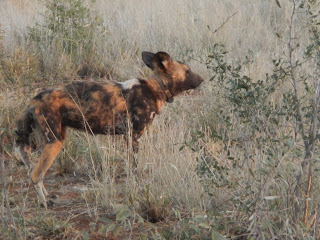Angola used to be home to vast amounts of wildlife just like
its neighboring countries still have, but during the civil war all of the
animals were killed. Angola is now home to only one functional (though
semi-functional at best) national park, which is a fenced in area where some
animals like elephants and giraffes have been reintroduced.
Quiçama National
Park, located just outside of the capital city of Luanda has a lodge where
visitors can stay, and offers safari drives a couple times throughout the day.
In order to visit the park, my mom and I had to take two cars and drivers with
us (just in case one breaks down), so we went out this past Wednesday with our
drivers Antonio and Alberto, to visit the park.
To reach Quiçama,
one has to drive outside the city, and then about 40 km down a dirt road to
reach the entrance, and then even further once within the fence of the park to
reach the lodge. We arrived around 10:30 ready to take the safari at 11 am.
The view from the restaurant at the lodge is absolutely
beautiful, but you have to be careful while eating here because monkeys are
everywhere!
 |
| The view from the lodge at Quiçama National Park |
 |
| One of the many monkeys! |
Now back to this safari drive, we head up to the main desk at 11 but there is not a safari truck in sight. Around 12 it finally returns so we finally set out at 12:15. This safari truck, like most, is completely open at the back, so that we have a good view of the wildlife (the few there are). However, once we got in we noticed how ripped up the edges of each seat was, and how banged up the sides of the truck were.. turns out the driver isn't one to avoid hitting trees as we drive along...
Anyways the drive starts off fine, with my mom and I, our two drivers, and three German tourists, and we set off down a dirt roads to hopefully see some animals. After a little while we come across some giraffes a little way off the path, so we figured we would stop and look from a distance, though the driver and his helper have another idea. And off the path we go into the bush driving straight for the giraffes.
 |
| Giraffes |
After this brief detour we manage to get through some bushes and end up back on a dirt trail again. We venture on for another hour or so, we see some different types of antelopes like Bushbuck and Kudu, and we head down towards the water (I'm assuming looking for the elephants). Now you are probably thinking, well some off-roading, but not too bad, sounds like a pretty fun safari.
Our driver then decides we are leaving the trail again and heads off on another trail (or not trail as the case may be) into the bushes. We continue deeper and deeper into the bushes with trees coming in both sides of the truck. As we get deeper into the bushes, the 7 of us in the back are trying to avoid being hit by all the branches coming at us, and we get to the point where the 7 of us are kneeling down in the middle of the truck with our hands over our heads trying to protect ourselves from these trees branches coming at us from all sides. And then we suddenly stop. Here we are stuck in the bushes, with a tree pretty much inside the truck taking over half of our seats, and the truck has broken down. (I wish I had a better picture but the driver and his helper never talked to us during this whole ordeal so we weren't allowed out the back of the truck...)
 |
The tree that joined us in the truck.
|
Anyways, so the driver's helper now gets out a screwdriver to open the front of the car, and proceeds to add some oil, to try and get us started again. Only problem being we are wedged between trees on both sides. But eventually we rock our way out and follow this helper who is walking around looking for a route out...
After this episode, you would assume that we would just get back on the main trail and follow it hoping that we might actually see some wildlife... However, this new trail that we were now on was getting muddier and muddier, and eventually turned into water hole of sorts. Stuck once again we turned around headed back on the main trail returning to the lodge almost 3 hours after we left... and alas we never found the elephants.
I guess I now know what it means to go on a safari in Angola.. and though it doesn't involve seeing much wildlife.. it definitely does involve a new adventure. You have been forewarned if you decide to come and visit the park!




























